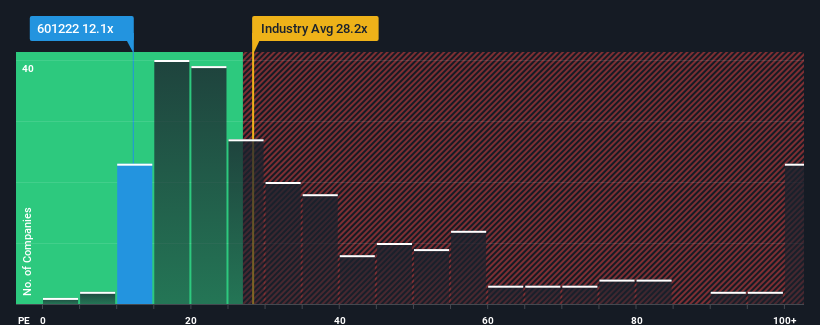- China
- /
- Electrical
- /
- SHSE:601222
Investors Don't See Light At End Of Jiangsu Linyang Energy Co., Ltd.'s (SHSE:601222) Tunnel

Jiangsu Linyang Energy Co., Ltd.'s (SHSE:601222) price-to-earnings (or "P/E") ratio of 12.1x might make it look like a strong buy right now compared to the market in China, where around half of the companies have P/E ratios above 28x and even P/E's above 53x are quite common. Nonetheless, we'd need to dig a little deeper to determine if there is a rational basis for the highly reduced P/E.
Recent times have been advantageous for Jiangsu Linyang Energy as its earnings have been rising faster than most other companies. It might be that many expect the strong earnings performance to degrade substantially, which has repressed the P/E. If not, then existing shareholders have reason to be quite optimistic about the future direction of the share price.
View our latest analysis for Jiangsu Linyang Energy

What Are Growth Metrics Telling Us About The Low P/E?
Jiangsu Linyang Energy's P/E ratio would be typical for a company that's expected to deliver very poor growth or even falling earnings, and importantly, perform much worse than the market.
Taking a look back first, we see that the company managed to grow earnings per share by a handy 5.7% last year. Still, lamentably EPS has fallen 12% in aggregate from three years ago, which is disappointing. Therefore, it's fair to say the earnings growth recently has been undesirable for the company.
Turning to the outlook, the next three years should generate growth of 13% per year as estimated by the four analysts watching the company. That's shaping up to be materially lower than the 24% each year growth forecast for the broader market.
With this information, we can see why Jiangsu Linyang Energy is trading at a P/E lower than the market. It seems most investors are expecting to see limited future growth and are only willing to pay a reduced amount for the stock.
The Final Word
Using the price-to-earnings ratio alone to determine if you should sell your stock isn't sensible, however it can be a practical guide to the company's future prospects.
As we suspected, our examination of Jiangsu Linyang Energy's analyst forecasts revealed that its inferior earnings outlook is contributing to its low P/E. At this stage investors feel the potential for an improvement in earnings isn't great enough to justify a higher P/E ratio. It's hard to see the share price rising strongly in the near future under these circumstances.
It is also worth noting that we have found 2 warning signs for Jiangsu Linyang Energy (1 can't be ignored!) that you need to take into consideration.
Of course, you might also be able to find a better stock than Jiangsu Linyang Energy. So you may wish to see this free collection of other companies that have reasonable P/E ratios and have grown earnings strongly.
New: Manage All Your Stock Portfolios in One Place
We've created the ultimate portfolio companion for stock investors, and it's free.
• Connect an unlimited number of Portfolios and see your total in one currency
• Be alerted to new Warning Signs or Risks via email or mobile
• Track the Fair Value of your stocks
Have feedback on this article? Concerned about the content? Get in touch with us directly. Alternatively, email editorial-team (at) simplywallst.com.
This article by Simply Wall St is general in nature. We provide commentary based on historical data and analyst forecasts only using an unbiased methodology and our articles are not intended to be financial advice. It does not constitute a recommendation to buy or sell any stock, and does not take account of your objectives, or your financial situation. We aim to bring you long-term focused analysis driven by fundamental data. Note that our analysis may not factor in the latest price-sensitive company announcements or qualitative material. Simply Wall St has no position in any stocks mentioned.
Have feedback on this article? Concerned about the content? Get in touch with us directly. Alternatively, email editorial-team@simplywallst.com
About SHSE:601222
Jiangsu Linyang Energy
Provides energy meters, and system products and accessories in China and internationally.
Flawless balance sheet with high growth potential.
Similar Companies
Market Insights
Community Narratives



